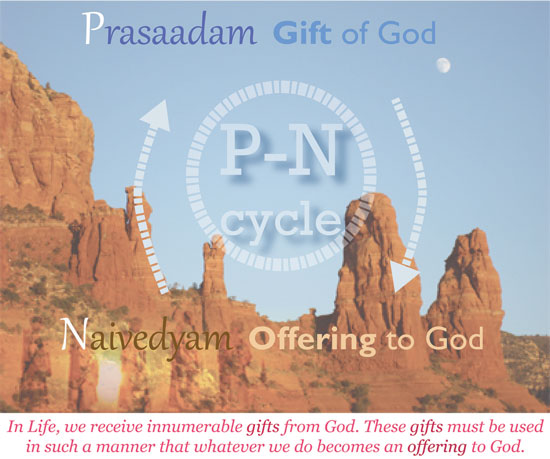|
|
| 'Like' us on Facebook | Follow us: |
Posted on : Jan 03, 2013
RADIO SAI STUDY CIRCLE – 8
SOS: Swami On Sadhana
Part 04
HIGHER SADHANA – SEEKING GOD WITHIN
 |
SG: I remember a beautiful event that happened in 1999. The institute’s MBA students were seated at Sai Kulwant Hall and were praying to Swami for a group interview. And they all said, “Swami, please give us an interview. Please give us an interview.” Swami replied with a smile, “Wife lekhe aao, interview dehta hai (Get your wife and I will give you an interview)”.
GSS: Everybody would have had a good laugh.
SG: They laughed thinking that Swami is joking and continued with their pleading. As Swami started walking away, He stopped for a moment, turned and said, “Boys, did you not understand what I said just now?”
Then He drew a beautiful analogy. He said, “Your mind is your wife, the Atma is the husband. When the mind is in perfect tune with the Atma, it has perfect understanding with your conscience and there is peace and harmony at home which is our own self, our body. But if the mind and Atma go in two different directions…” Swami punned with the word and said, “The result will be diverse”.
Swami did not disagree for an interview, but He was giving the boys a much more important message. Swami was stressing on the important message that ‘inner view’ was more important than an interview! And to get that inner view the mind has to be in tune with the Atma, which is inside us, which is the very core of our being.
BP: Beautiful!
AD: You would have observed that throughout Swami has presented to many devotees and students different types of diamond rings – green diamonds, white diamonds, three diamonds, six diamonds and so on.
GSS: Haven’t we watched those fingers!
SG: We used to call it a grand slam!
AD: Yes. Swami used to pun with the word ‘Diamond’ too. He said, “Diamond actually means ‘Die Mind’”. That is when you are able to shut your mind or crush your mind completely - it becomes as precious as a diamond. Just as a diamond sparkles in light, if you cut your mind, the inner self will sparkle forth.
SG: To give more clarity on what is to end the mind, Swami says, “See, we have thousands of thoughts running in our mind. Through Namasmarana focus it on one thought first.”
GSS: One needs to channelize it.
SG: And after sometime even that one thought has to be relinquished and that is really the end of the mind. In that absolute nothingness the mind is like a mirror that reflects the light of the Atma.
AD: Many to one and one to none.
KMG: When we talk about mind, there’s one more analogy that comes to my mind. Most people tend to blame God. They say, “God, you have created the world, and all this maya is your making. So why are we trapped?”
Once a devotee addressed Bhagawan as Maya Swaroopa (Embodiment of Maya). Swami immediately answered, “No, I am not Maya Swaroopa, I am Jyothi Swaroopa - I am the Embodiment of Light.” Swami said that one should not blame the sun for the shadow. The shadow is formed due to the object. The object is one’s mind. The entire Sadhana is all about nullifying the mind. The moment you nullify the mind you have reached the goal.
BP: Talking about nullifying the mind and purifying the inner self, I remember a very beautiful analogy that Swami provides on this topic. He said that when you are drilling the ground fixing a pipe to draw water, you have to ensure that no air or water gets into the pipe because vacuum is necessary to draw water. Swami said our inner self is like that. Our outer self should not in any way contaminate the inner self. Only when we do not allow the outer self to influence the inner self and keep the inner self clean can we really connect and go inward.
GSS: Swami also advices not to dig shallow borewells because you really won’t reach God. Rather dig just one borewell and reach right to him.
 |
KMG: That’s why we are told to focus within. This means that all the contamination and delusion is outside. Swami says when you are sitting in a train and look outside at another train that is running parallel to your train, it would seem that your train is stationary while the other is moving. Swami says that is maya. What is the solution to overcome this? Look into your train - look within.
SG: When a thorn pricks your foot, you would not merely sit. You would try to remove it.
KMG: Yes. Get rid of it instead of analysing the intensity of pain.
GSS: And the solution to that is only one and that is Sai.
KMG: Sai?
BP: Yes.
GSS: SAI means See Always Inside. You travel miles and miles across various places and through various means to visit a temple. As soon as you see the idol of the Lord you close your eyes because, by instinct, the mind knows that it has to see God within. Swami gives a very beautiful example in this regard.
A bird is sitting high on the branch of a tree that is violently shaking due to a huge storm. But the bird is calm and does not move. One would wonder as to how the bird is so calm despite the storm. And then suddenly the branch breaks. What would happen now? The bird just flies away. The bird's equanimity is because it depended only on its wings. Though it appeared to be sitting on the branch, the branch was not its basis. The wings were its basis. In the same way if our true self or the Atma is what we are anchored in though we live in the world, we will remain unruffled because we will look within. So looking within is really the key and that is the goal of Namasmarana.
Let us take up a few examples of what does surrender really mean or at what point can we say that we have really surrendered to God.
SURRENDER – THE FINAL GOAL OF SADHANA
SG: Speaking about surrender, I would like to share an experience that I have had. Bhagawan had once given a student an opportunity to ask a few questions.
One of our brothers had asked Swami, “What is surrender?” Bhagawan answered through a beautiful analogy. He asked all of us, “How many of you know how to drive a car?” A few of us raised our hands.
He then asked, “How many gears does a car have?” We said, “Swami, it has four gears.”
Swami said, “Do you know that life also has four gears?” He said, “The first gear is happiness, second gear is sorrow, third gear is happiness and fourth gear is sorrow”.
 |
 |
 |
 |
 |
 |
 |
 |
He said, “If you are in the neutral gear, the vehicle of life will go smoothly without much turbulence, but the problem comes when you are in any of the other gears - that is the gears of happiness or sorrow.”
In fact, He went on to explain further, “Even when you are in the first gear you are going at a constant speed, do you feel any turbulence?” We said, “No Swami.”
Then He asked us, “When does the problem arise?” We all said, “Swami, when we try to accelerate we have to move to the next gear.”
He said, “What will happen if you directly move to the next gear?”
We said, “Swami, the car will jerk and might even stop if we don’t engage the clutch.”
Swami said the key is to press the clutch. In the same way, in our life too, either when we are happy or sad for a long time, we get used to it. But the problem comes when we transit from moments of joy to moments of sorrow. And Swami said at those moments when we transit from joy to sorrow or from sorrow to joy, press the clutch called ‘Surrender’. Bhagawan here means the sorrows and joys are gifts of God for our own growth and welfare. If we have firm faith and conviction in this principle, Bhagawan says surrender will act as a clutch ensuring smooth transition in the various changes that happen in our life.
GSS: So whatever happens is good.
SG: Whatever happens is God’s gift for me.
 |
KMG: Another example that Swami gives is that of Kumkum Archanam (ritualistic worship by vermillion). Bhagawan explained that Kumkum basically signifies blood and blood in turn signifies life. Thus, no blood means no life. So when a spiritual aspirant is offering Kumkum he or she is actually offering his or her own life to the Divine Mother. Here offering life means offering one's action, one's thought, word and one's will to the Divine Will. Here the act of Kumkum Archanam actually symbolises the spirit of surrender.
BP: If there is a minor in a family, the minor cannot stake claim to paternal property. It may do so only after it becomes a major. Swami says that is what Sadhana can do. Once you start doing Sadhana, once you surrender to God you have access to your true heritage. You have access to the heritage of God. Swami also says that when we say “I”, we will feel alone. But when we say “Not I, but You”, we will receive His grace. Then, everything shall be given to you, Baba says.
AD: I am reminded of a concept we used to discuss in our Awareness classes. This was the P and N cycle. P stands for Prasadam and N stands for Naivedyam. What we receive from God is prasadam and what we offer Him is naivedyam, which we, in turn, receive as prasadam – P-N-P. We should have this feeling that whatever we receive in life is His prasadam and that should be offered to Him as naivedyam.
GSS: I am reminded of another very good example Swami gives about surrender. He says there are two ways in which you can surrender – like that of the monkey or the cat. When a female monkey jumps from tree to tree, it's the young one which clings onto the mother's belly. It is the responsibility of the baby to cling on because as the monkey jumps from tree to tree, it does not hold on to the baby. It is the onus of the baby. But the cat, on the other hand, holds the kitten very softly in its jaws without hurting the kitten. In this case, it is the responsibility of the mother cat to hold on to the kitten. The kitten has only to relax. Swami says that of both the forms of surrender, the one of the cat is higher as you leave everything to the Lord.
AD: It’s like Jnana Yoga and Bhakthi Yoga. Bhakthi Yoga is like the faith of the kitten, while in Jnana Yoga you are responsible.
GSS: I hold on and take up the responsibility. These are wonderful examples that Swami gives about surrender. And I think this is what the path of Sadhana is all about. We have seen the prerequisites to Sadhana, we have seen the process of Sadhana where we talked of Namasmarana, seeking within and ultimately all this should lead to total surrender to God because that’s what life is all about. We are not the doer, we are just puppets in His hands. We should do our duty, but ultimately it is He who is doing it through us – we are just His instruments. I think it would be very apt to end this study circle talking about the critical success factors.
 |
Sadhana is fine but what is it that will make it click? Does Swami offer any tips?







